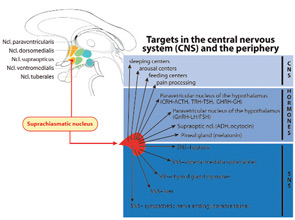From these data, it is evident that the amplitude of the curve of cytokine production is higher and the curve is broadened in RA as compared to controls. In healthy subjects, serum levels of IL-6 usually decrease by 9 a.m. whereas, in RA patients, these levels can remain elevated until 11 a.m. The increased amplitude and the broadened curve in the morning hours are important for the morning symptoms. Interestingly, a circadian rhythm exists for the production of immunoglobulins in RA, as has been demonstrated for IgA–rheumatoid factor (peak at 8 a.m.).3 Furthermore, circulating immune complexes demonstrate a circadian rhythmicity in RA with a peak between 6 and 9 a.m.4 These findings demonstrate that two other important disease-relevant parameters display an elevation in the early morning hours in patients with RA.

In view of these observations, the key question is, What is driving the circadian oscillation of serum levels of cytokines?
Circadian Rhythm of Cortisol
The adrenal hormone cortisol is an endogenous steroid with anti-inflammatory actions. In the 1950s and 1960s, shortly after the discovery of cortisol, the circadian rhythm of this hormone was described. The cycle of the hypothalamic-pituitary-adrenal (HPA) axis has a maximum in the early morning hours at 8 a.m. and a nadir at midnight (see Figure 3, p. 16). Detailed analyses of the circadian curves of cytokines and cortisol have revealed a lag time between the cortisol rise in comparison to the increase of cytokine of approximately 60–120 min.5 From this study and a recent analysis of several independent investigations, it appears that morning cytokines can drive the increase of cortisol.2
Interestingly, the cortisol rhythm in healthy subjects does not differ from that of patients with RA when disease activity is relatively low to moderate. This similarity pertains to the period, the amplitude, and the time point of the minimum and peak of the cycle. Studies have shown, however, that this rhythm can be disturbed in patients with RA when disease activity is high, leading to a flattening of the hormone curve. Nevertheless, the serum levels of cortisol are similar in healthy subjects compared to patients with RA.